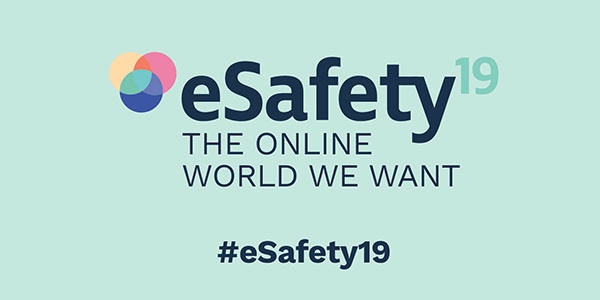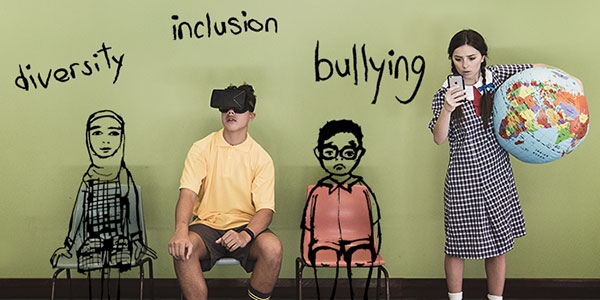The online world can be an exciting, empowering and challenging place. Cyber safety education is essential if we want to create a more positive future for young people.
The 2019 eSafety Conference was held in Sydney in September. Hosted by The Office of the eSafety Commissioner and Netsafe New Zealand, eSafety 2019 was an opportunity for the world’s foremost academics, industry leaders, educators, policy makers and young people to come together and discuss the biggest online safety issues of our time. The focus of this year’s event was on working together to create an online world that is positive, inclusive and safe for everyone.
One of the big talking points this year was ‘safety by design’. Safety by design refers to the responsibility of technology companies to put the safety and rights of users at the centre of the design, development and deployment of online products and services. It’s about creating platforms that are helpful rather than harmful right from the start, rather than waiting until the damage is done. It was encouraging to hear there is growing pressure on tech companies to prioritise the safety of children, adolescents and other vulnerable groups, such as people from culturally and linguistically diverse backgrounds, LGBTI+ youth, people with a disability, young people in out-of-home care and people in domestic violence situations.
It was also comforting to learn that approximately 80% of all online interactions are ‘low-risk’, according to Carlos Figueiredo, Director of Community Trust & Safety at Two Hat Security. In other words, the vast majority of online interactions are neutral, harmless or even positive.
The conference also looked at strategies for combating online dangers such as child sexual abuse and exploitation, grooming, scams, identity theft, technology-facilitated domestic abuse, sexploitation and image-based abuse.
The conference highlighted that we must learn to hold both the positive and negative aspects of the online world in tension with one another if we are going to move forward in the online safety space. While the conference addressed some of the darkest aspects of the internet, it also offered a lot of hope.

The future of cyber safety education
One of the most important issues on the conference agenda was the vital role of cyber safety education. We heard from young people, researchers and other experts about the key priorities for cyber safety education and where cyber safety educators should be focusing their attention as they look to the future.
Digital natives engage with the online world in a way that older generations never will. Tessy Ojo, CEO of The Diana Award, reminded us there is no longer a distinction between the ‘online world’ and the ‘offline world’ – for young people, this is just the world.
It is true that many people behave differently when they are behind a screen. Technology can provide a sense of anonymity that changes our behaviour and decision-making, in both positive and negative ways. While tech companies do have a responsibility to design safe products, we need to remember that technology doesn’t hurt people, people hurt people. Technology is just a tool.
We therefore need to focus on nurturing social and emotional competencies, such as empathy, self-regulation, self-efficacy, kindness, compassion, assertiveness, values, resilience, responsibility, positive bystander behaviour and ethics. We need to target behaviours, not technologies. We must also give young people agency by including them actively in conversations about cyber safety and the issues that matter most to them.

At the eSafety Conference, we learnt that the most effective approaches to changing negative online behaviours are the same approaches that are effective for changing negative offline behaviours. Dr Sameer Hinduja, Co-Director of the US Cyberbullying Research Center, offered an array of creative strategies to help reduce the prevalence and impact of cyber bullying. Most of these strategies were aimed at improving the social and emotional skills of young people, helping them to build a positive school climate, and creating a greater sense of social responsibility and belonging.
Online safety education is relevant to all aspects of a young person’s life and should be introduced from an early age. Dr David Finkelhor, Director of the Crimes Against Children Research Center, Co-Director of the Family Research Laboratory and Professor of Sociology at the University of New Hampshire, told us that the most effective cyber safety education strategies are those that are integrated into existing student wellbeing programs. Rather than offering stand-alone cyber safety programs, we should be weaving cyber safety education through the evidence-based frameworks that are already established in schools, such as existing mental health programs and anti bullying programs. Dr Finkelhor also stressed that cyber safety education must be based on the latest research, and cyber safety programs should be constantly updated.
Professor Kerryann Walsh from Queensland University of Technology presented a new Online Safety Education Framework for Australian Schools. This framework, developed in collaboration with the eSafety Commissioner, is the result of extensive research on the most effective approaches to cyber safety education around the world. One of the key messages that came out of this research is that cyber safety education should be delivered using a range of teaching styles and learning experiences. According to eSafety Commissioner Julie Inman Grant, children and young people need “multiple exposures to online safety, using varied educational platforms”.
How is Brainstorm Productions contributing to cyber safety education in Australian schools?
At Brainstorm Productions, we offer a unique method for delivering messages about cyber safety, mental health and bullying: through the medium of live theatre. Our school theatre productions offer stimuli for further learning, engaging students on an emotional level and offering a starting point for further discussion. The post-performance Q&A with the actors and the follow-up classroom activities are used to expand on the messages, and link them to the curriculum and key learning outcomes.

Our cyber safety programs are updated regularly, and are informed by current literature and recommendations from trusted sources such as The Office of the eSafety Commissioner, Beyond Blue, headspace, Orygen National Centre for Excellence in Youth Mental Health, the Black Dog Institute and Bullying. No Way!.
High school productions such as ‘Cyberia’ deliver mental health, bullying and cyber safety education through an in-depth narrative. ‘Cyberia’ is a mental health, cyber safety and bullying program for high school students that goes beyond simply providing information – the issues are raised in the context of the characters’ complex lives, including their relationships with family, friends, peers and self identities. We raise questions that do not necessaryily have black and white answers, such as “how can online gaming be used to enhance rather than hinder our mental health?”, “when is it better to communicate face-to-face rather than online?” and “what can I do if I make a mistake online?”. The aim is for students to come away from the experience with a more nuanced understanding of the issues and potential solutions.
Primary school productions such as ‘Buddies’ are an exciting way for teachers to present cyber safety education to their students. ‘Buddies’ is a cyber safety, resilience and bullying program for primary school students that encourages children to think about the kind of friend they want to be, both online and offline, and offers skills that can be reinforced and practiced in the classroom.
Our cyber safety, resilience and bullying programs are all embedded within the framework of social and emotional learning. The aim is to reinforce messages that are already being taught in the classroom and engage students in meaningful conversations about the issues.
Underlying all of our productions is the understanding that positive human connections are central to our wellbeing, resilience, mental health and safety.
For more reflections on the 2019 eSafety Conference, and for more cyber safety articles and anti bullying articles, go to the Cyber Bullying Research Center’s blog.
Click here to find out more about our productions for high schools.
Click here to find out more about our productions for primary schools.





